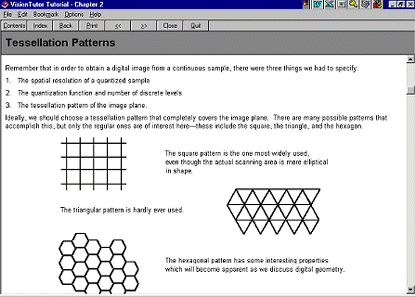Aphelion Vision Tutorby Adcis
The VisionTutor? computer vision course is a combined theoretical and laboratory package designed as an introductory course in Image Processing and Image Understanding.
The VisionTutor™ computer vision course is a combined theoretical and laboratory package designed as an introductory course in Image Processing and Image Understanding. The format of the course makes it possible for colleges, universities, research labs, and in-house trainers to present computer vision techniques in a manner that will prepare students and end-users to both understand and apply the algorithms and techniques of this dynamic field. The format of this course is unique, as it consists of computer-based text, graphics, hyperlinks, and direct links to the Aphelion image processing software. All the exercises in the laboratory section are delivered as macro command code that can be run from the Aphelion Developer, a PC environment for Image Processing and Image Understanding research and application development.

Components
VisionTutor consists of lecture material and a laboratory experiments as a mix of hypertext, graphics and Aphelion macros. The lecture material is grouped into eight chapters, each with an average of 80 pages per chapter. Each time a new concept is introduced, a laboratory exercise is made available to the user from an on page icon. Clicking the icon will automatically transition the user into the Aphelion environment, and start the exercise as a macro file. The macro includes text, image display, and interaction with the user. At the completion of the exercise, the system will return to the lecture material. All of the macros are delivered as source code, allowing the student or the teacher to modify them.
Lecture Materials
The lecture materials are based on the Computer Vision course given by Professor Allen Hanson at the University of Massachusetts at Amherst. The lecture material, allows students to interactively explore the concepts of computer vision, image processing and image understanding, and gain a working knowledge of the algorithms.
Laboratory Materials
The laboratory section of VisionTutor requires and uses the Aphelion software environment. The VisionTutor Lab module is composed of a set of Visual Basic compatible macro routines, fully compatible with Aphelion, and associated text.
The experiments step students through the software environment, thereby self-instructing them in the use of the lab tools. The experiments enable the student to explore the nature of computer vision algorithms by interacting with operators and images, and looking at the results. In most cases, the students have the option of also running the experiment on their own image data.
Aphelion
The Aphelion system is a general-purpose software development environment, available in all Windows environments, providing the state of the art tools for Image Understanding. It is widely used for research and application development, in the fields of medical, materials science, geology, quality control, military, and inspection imaging.
VisionTutor Course Syllabus
- Introduction - The course starts with an overview and an introduction to computer vision concepts. The corresponding Lab material teaches basic Aphelion System interaction, such as using the Graphical User Interface, and running an Aphelion Visual Basic compatible macro.
- Image Formation - The Image Formation section explores the basic issues of digital imagery: geometry, radiometry, photometry and digitization. This section concentrates on the digitization process, particularly in terms of how an image can be viewed as a mapping of the actual scene.
- Image Enhancement - This section explores linear and non-linear filtering, histogram equalization, and other image enhancement techniques.
- Edge Detection - Various types of edge detection schemes, such as first and second derivative, Sobel, Prewitt and facet models, are covered in this section. Other related topics, such as edge thresholding and edge thinning, are also discussed.
- Morphology - This section describes binary and gray scale morphology. Examples are used to show the theoretical nature of these operators, and how they are used in various applications.
- Region Segmentation - The Region Segmentation section explores a variety of region segmentation algorithms, such as region split and merge techniques, region growing, histogram peak/valley analysis, and a number of thresholding methods.
- Convolution, Filtering and Fourier Transform - This section explores the applications of these fundamental image processing techniques. Also covered is the important relationship between the spatial processing approach of convolution and the frequency processing approach of Fourier filtering.
|

